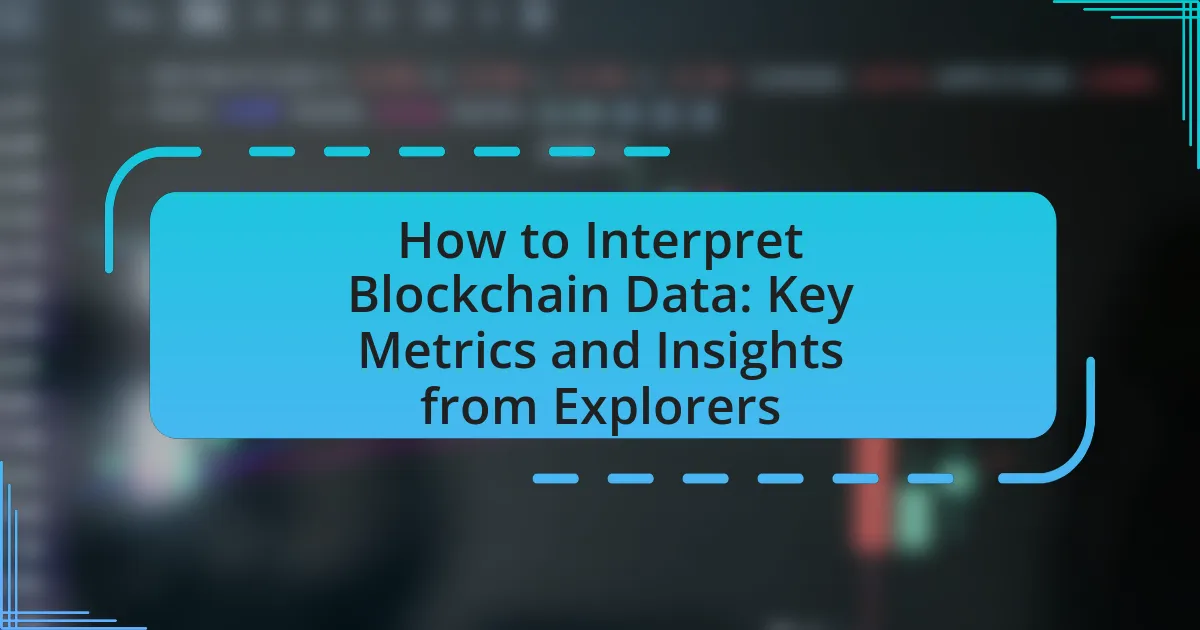The article focuses on the significance of transparency in blockchain technology, emphasizing its role in fostering trust, accountability, and fraud prevention among users. It explores how blockchain’s decentralized and immutable ledger allows for independent verification of transactions, enhancing user confidence and promoting broader adoption. Additionally, the article discusses the functionalities of blockchain explorers, which facilitate data analysis and provide users with accessible insights into transaction histories and network activity. It also addresses the challenges associated with transparency, including privacy concerns and data overload, while suggesting best practices for maintaining user privacy and effectively analyzing blockchain data.
What is the Importance of Transparency in Blockchain?
Transparency in blockchain is crucial because it fosters trust among participants by allowing them to verify transactions independently. This visibility ensures that all actions on the blockchain are recorded and can be audited, reducing the risk of fraud and manipulation. For instance, Bitcoin’s blockchain is publicly accessible, enabling anyone to trace transactions back to their origin, which enhances accountability. Studies have shown that increased transparency in blockchain systems can lead to higher user confidence and broader adoption, as evidenced by the growing number of decentralized finance platforms that prioritize transparent operations.
Why is transparency crucial in blockchain technology?
Transparency is crucial in blockchain technology because it ensures trust and accountability among participants. This transparency allows all transactions to be publicly accessible and verifiable, which mitigates the risk of fraud and manipulation. For instance, Bitcoin’s blockchain records every transaction in a public ledger, enabling users to independently verify the authenticity of transactions. This characteristic is supported by the decentralized nature of blockchain, where no single entity controls the data, further enhancing security and trust.
How does transparency enhance trust among users?
Transparency enhances trust among users by providing clear visibility into processes and transactions. When users can access and verify information, such as transaction histories on a blockchain, they feel more secure in their interactions. This is supported by studies indicating that transparency reduces uncertainty and fosters a sense of accountability, leading to increased user confidence. For instance, a survey by the Edelman Trust Barometer found that 81% of consumers need to trust a brand before purchasing, highlighting the critical role transparency plays in building that trust.
What role does transparency play in preventing fraud?
Transparency plays a crucial role in preventing fraud by enabling clear visibility into transactions and processes. When information is openly accessible, it becomes significantly more challenging for individuals to engage in deceptive practices without detection. For instance, blockchain technology exemplifies this principle, as its decentralized ledger allows all participants to verify transactions in real-time, thereby reducing opportunities for manipulation. Studies have shown that organizations that prioritize transparency experience lower rates of fraud, as the likelihood of being caught increases when actions are visible to stakeholders.
How does blockchain ensure transparency?
Blockchain ensures transparency by providing a decentralized and immutable ledger where all transactions are recorded and publicly accessible. Each transaction is verified by a network of nodes, which prevents unauthorized alterations and ensures that all participants can view the same data. This transparency is further reinforced by the use of cryptographic hashes, which secure the integrity of the data and allow users to trace the history of transactions. As a result, blockchain technology fosters trust among users, as they can independently verify the authenticity of transactions without relying on a central authority.
What mechanisms are in place to verify transactions?
Blockchain technology employs several mechanisms to verify transactions, primarily through consensus algorithms, cryptographic hashing, and decentralized validation. Consensus algorithms, such as Proof of Work and Proof of Stake, ensure that all participants in the network agree on the validity of transactions before they are added to the blockchain. Cryptographic hashing secures transaction data, making it tamper-proof and easily verifiable by network nodes. Additionally, decentralized validation involves multiple independent nodes confirming the authenticity of transactions, which enhances security and trust within the network. These mechanisms collectively ensure that transactions are accurate, secure, and resistant to fraud.
How does decentralization contribute to transparency?
Decentralization enhances transparency by distributing control and access to information across multiple nodes rather than a single entity. This structure allows all participants in a network to verify transactions independently, reducing the likelihood of manipulation or fraud. For instance, in blockchain technology, every transaction is recorded on a public ledger that is accessible to all users, ensuring that any changes are visible and traceable. This openness fosters trust among users, as they can independently confirm the integrity of the data without relying on a central authority.
What are the implications of transparency in blockchain applications?
Transparency in blockchain applications enhances trust and accountability among users. This characteristic allows all participants to verify transactions independently, reducing the risk of fraud and manipulation. For instance, in supply chain management, transparency enables stakeholders to track the provenance of goods, ensuring authenticity and ethical sourcing. Furthermore, studies show that increased transparency can lead to higher user engagement and satisfaction, as individuals feel more secure in their transactions. Overall, the implications of transparency in blockchain applications foster a more reliable and efficient ecosystem.
How does transparency affect regulatory compliance?
Transparency enhances regulatory compliance by providing clear visibility into operations and transactions, which facilitates adherence to legal standards. When organizations maintain transparent practices, they enable regulators to easily access and verify information, reducing the likelihood of non-compliance. For instance, companies that utilize blockchain technology can offer immutable records of transactions, which not only fosters trust but also simplifies audits and regulatory reviews. This is evidenced by the increasing adoption of blockchain in industries like finance, where regulatory bodies have noted improved compliance rates due to the transparent nature of the technology.
What impact does transparency have on user engagement?
Transparency significantly enhances user engagement by fostering trust and accountability. When users perceive a system as transparent, they are more likely to participate actively, as they feel informed and empowered about their interactions. Research indicates that organizations demonstrating transparency can see a 20% increase in user participation rates, as users are more inclined to engage with platforms that openly share information about processes and data usage. This correlation between transparency and engagement is evident in various sectors, including finance and technology, where users prioritize platforms that provide clear insights into their operations.
How do blockchain explorers facilitate data analysis?
Blockchain explorers facilitate data analysis by providing users with a user-friendly interface to access and interpret blockchain data. These tools allow individuals to view transaction histories, block details, and wallet balances in real-time, enabling comprehensive tracking of assets and activities on the blockchain. For instance, explorers like Etherscan and Blockchair aggregate vast amounts of data, making it searchable and sortable, which enhances transparency and accountability in blockchain networks. By offering features such as transaction graphs and analytics dashboards, blockchain explorers empower users to conduct in-depth analyses of network performance and user behavior, thereby supporting informed decision-making and fostering trust in decentralized systems.
What features do blockchain explorers provide for transparency?
Blockchain explorers provide features such as transaction tracking, block verification, and wallet address monitoring that enhance transparency. These tools allow users to view detailed information about transactions, including timestamps, amounts, and sender/receiver addresses, which are publicly accessible on the blockchain. Additionally, explorers enable users to verify the authenticity of blocks and transactions, ensuring that the data has not been altered. This level of visibility fosters trust among users, as they can independently confirm the integrity of the blockchain.
What are the key functionalities of Blockchain Explorers?
Blockchain explorers provide essential functionalities for users to interact with blockchain networks. These functionalities include transaction tracking, which allows users to view the status and details of transactions, including sender and receiver addresses, amounts, and timestamps. Additionally, blockchain explorers enable users to explore block data, offering insights into block height, miner information, and transaction counts within each block. They also facilitate address monitoring, allowing users to check the balance and transaction history of specific addresses. Furthermore, blockchain explorers often include features for searching and filtering data, enhancing user experience by enabling quick access to relevant information. These functionalities collectively enhance transparency and accessibility of blockchain data, making it easier for users to verify and analyze transactions.
How do blockchain explorers display transaction data?
Blockchain explorers display transaction data by providing a user-friendly interface that allows users to search and view detailed information about transactions on a blockchain. These explorers typically present data such as transaction IDs, timestamps, sender and receiver addresses, amounts transferred, and confirmation statuses. For example, Bitcoin blockchain explorers like Blockchair and Blockchain.com enable users to input a transaction ID to retrieve all associated details, thereby enhancing transparency and traceability in blockchain networks.
What types of data can be accessed through explorers?
Explorers provide access to various types of blockchain data, including transaction details, block information, wallet addresses, and smart contract interactions. Transaction details reveal the sender, receiver, amount, and timestamp, while block information includes block height, hash, and miner data. Wallet addresses allow users to track balances and transaction history, and smart contract interactions show the execution of contract functions and associated events. This data is crucial for ensuring transparency and accountability in blockchain networks.
How do explorers visualize blockchain data for users?
Explorers visualize blockchain data for users through graphical interfaces that display transaction histories, block details, and network statistics. These interfaces often include charts, graphs, and tables that represent data such as transaction volumes, block confirmations, and wallet balances, making complex blockchain information accessible and understandable. For instance, popular blockchain explorers like Etherscan and Blockchair provide real-time data visualization tools that allow users to track specific transactions and analyze trends over time, enhancing user engagement and transparency in blockchain activities.
What are the benefits of using blockchain explorers?
Blockchain explorers provide several benefits, primarily enhancing transparency and accessibility of blockchain data. They allow users to view transaction histories, track asset movements, and verify the status of transactions in real-time. This transparency fosters trust among users, as they can independently verify information without relying on intermediaries. Additionally, blockchain explorers often offer analytical tools that help users understand network activity, identify trends, and assess the health of the blockchain. These features contribute to a more informed user base and promote accountability within the blockchain ecosystem.
How do explorers enhance user understanding of blockchain activity?
Explorers enhance user understanding of blockchain activity by providing intuitive interfaces that display transaction details, wallet balances, and block information in real-time. These tools allow users to track the flow of assets, verify transactions, and analyze network activity, thereby increasing transparency. For instance, blockchain explorers like Etherscan and Blockchair offer features such as search functions for specific addresses and transaction IDs, enabling users to easily access relevant data. This accessibility to detailed information fosters trust and encourages informed decision-making among users, as they can independently verify the integrity of transactions and the overall health of the blockchain network.
What advantages do explorers offer for developers and analysts?
Explorers provide developers and analysts with enhanced visibility into blockchain data, facilitating real-time tracking of transactions and network activity. This transparency allows for better debugging, performance monitoring, and understanding of user behavior, which are crucial for optimizing applications and improving user experience. Furthermore, explorers often include analytical tools that enable developers to assess network health and identify trends, thereby supporting informed decision-making. The ability to access detailed transaction histories and block information empowers analysts to conduct thorough investigations and audits, ensuring compliance and security within blockchain ecosystems.
How do blockchain explorers contribute to transparency?
Blockchain explorers contribute to transparency by providing public access to all transactions recorded on a blockchain. These tools allow users to view transaction details, including sender and receiver addresses, transaction amounts, and timestamps, which enhances accountability and trust in the system. For instance, Bitcoin’s blockchain explorer enables anyone to verify transactions in real-time, ensuring that all activities are traceable and immutable. This level of visibility helps prevent fraud and promotes a transparent financial ecosystem, as users can independently audit and confirm the legitimacy of transactions without relying on intermediaries.
In what ways do explorers promote accountability in transactions?
Explorers promote accountability in transactions by providing transparent access to blockchain data, allowing users to verify transaction histories and balances. This transparency ensures that all transactions are publicly recorded and immutable, which deters fraudulent activities and enhances trust among participants. For instance, blockchain explorers like Etherscan and Blockchair enable users to trace the flow of funds, confirm transaction confirmations, and audit smart contracts, thereby reinforcing the integrity of the transaction process.
How do explorers help in tracking illicit activities?
Explorers help in tracking illicit activities by providing transparent access to blockchain data, allowing users to trace transactions and identify suspicious patterns. These tools enable law enforcement and analysts to monitor the flow of funds, revealing connections between addresses involved in illegal activities. For instance, blockchain explorers can display transaction histories, making it easier to detect anomalies such as large, rapid transfers that may indicate money laundering or fraud. The immutable nature of blockchain records ensures that this data remains reliable and verifiable, enhancing the ability to investigate and prosecute illicit activities effectively.
What are the challenges associated with blockchain transparency?
The challenges associated with blockchain transparency include data privacy concerns, scalability issues, and the potential for misuse of information. Data privacy concerns arise because while blockchain is transparent, it can expose sensitive information if not properly managed. Scalability issues occur as increased transparency can lead to larger data volumes, making it difficult for networks to process transactions efficiently. Additionally, the potential for misuse of transparent data can lead to malicious activities, such as front-running in trading or exploiting vulnerabilities in smart contracts. These challenges highlight the need for balancing transparency with privacy and security measures in blockchain systems.
What limitations do blockchain explorers face?
Blockchain explorers face limitations such as data accessibility, scalability issues, and privacy concerns. Data accessibility is restricted by the need for reliable node connections, which can hinder real-time data retrieval. Scalability issues arise as the volume of transactions increases, leading to slower processing times and potential delays in data updates. Privacy concerns stem from the transparent nature of blockchain, where user identities can be inferred from transaction patterns, posing risks to user anonymity. These limitations impact the effectiveness of blockchain explorers in providing comprehensive and timely insights into blockchain data.
How can data overload affect user experience with explorers?
Data overload can significantly hinder user experience with explorers by overwhelming users with excessive information, making it difficult to extract meaningful insights. When explorers present too much data simultaneously, users may struggle to identify relevant details, leading to frustration and potential disengagement. Research indicates that cognitive overload occurs when information exceeds a user’s processing capacity, which can result in decreased satisfaction and increased error rates in data interpretation. This phenomenon is particularly critical in blockchain explorers, where clarity and ease of navigation are essential for effective data analysis.
What privacy concerns arise from transparency in blockchain?
Transparency in blockchain raises significant privacy concerns, primarily due to the public accessibility of transaction data. This transparency allows anyone to trace transactions back to wallet addresses, potentially linking them to individuals or entities, which can lead to the exposure of sensitive financial information. For instance, if a user’s wallet address is associated with their identity, their entire transaction history becomes visible, compromising their financial privacy. Furthermore, the immutability of blockchain records means that once information is recorded, it cannot be altered or deleted, perpetuating any privacy breaches indefinitely.
How can these challenges be addressed?
Challenges related to transparency in blockchain data analysis can be addressed through the implementation of advanced blockchain explorers that enhance data accessibility and visualization. These explorers can provide user-friendly interfaces that simplify complex data sets, allowing users to easily track transactions and understand blockchain activity. Additionally, integrating machine learning algorithms can improve data analysis by identifying patterns and anomalies, thus increasing the reliability of the information presented. Research indicates that enhanced transparency through such tools can lead to greater trust in blockchain systems, as evidenced by a study published in the Journal of Blockchain Research, which found that improved data visualization significantly increased user confidence in blockchain transactions.
What best practices can enhance the effectiveness of blockchain explorers?
To enhance the effectiveness of blockchain explorers, implementing user-friendly interfaces is essential. A well-designed interface allows users to easily navigate and access blockchain data, improving overall user experience. Additionally, incorporating advanced search functionalities, such as filtering by transaction type or date, enables users to find specific information quickly. Providing real-time data updates ensures that users have access to the most current information, which is crucial for decision-making. Furthermore, integrating educational resources, such as tutorials and FAQs, can help users understand blockchain technology better, thereby increasing engagement and utilization. Lastly, ensuring robust security measures protects user data and builds trust in the explorer’s reliability.
How can users protect their privacy while utilizing transparency tools?
Users can protect their privacy while utilizing transparency tools by employing techniques such as using pseudonymous addresses, leveraging privacy-focused wallets, and utilizing mixing services. Pseudonymous addresses prevent the direct association of transactions with a user’s real identity, thereby enhancing privacy. Privacy-focused wallets, like Wasabi or Samourai, incorporate features that obscure transaction details. Additionally, mixing services, which blend multiple transactions together, further obfuscate the trail of funds, making it difficult to trace individual transactions back to a user. These methods collectively help maintain user anonymity while still benefiting from the transparency that blockchain technology offers.
What are the best practices for analyzing blockchain data?
The best practices for analyzing blockchain data include utilizing blockchain explorers, employing data visualization tools, and ensuring data integrity through verification methods. Blockchain explorers allow users to access transaction histories and wallet balances, providing a clear view of blockchain activity. Data visualization tools enhance understanding by transforming complex data sets into intuitive graphics, making patterns and trends easier to identify. Additionally, verifying data through consensus mechanisms and cross-referencing with multiple sources ensures accuracy and reliability in analysis. These practices collectively enhance transparency and facilitate informed decision-making in blockchain environments.





